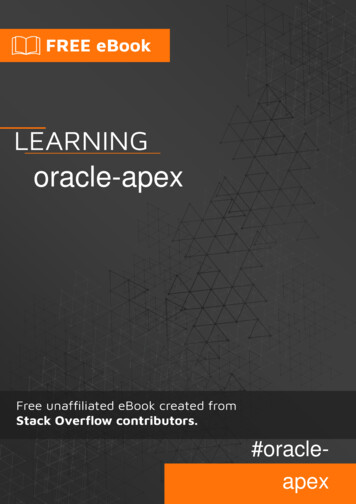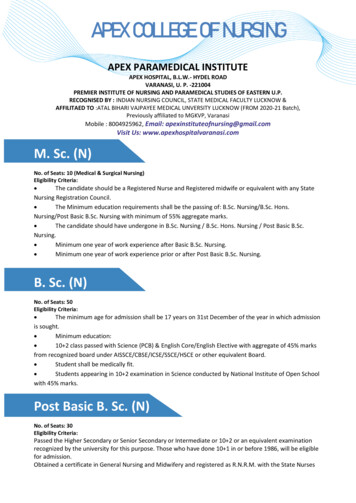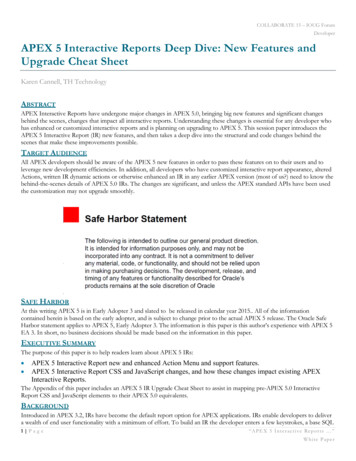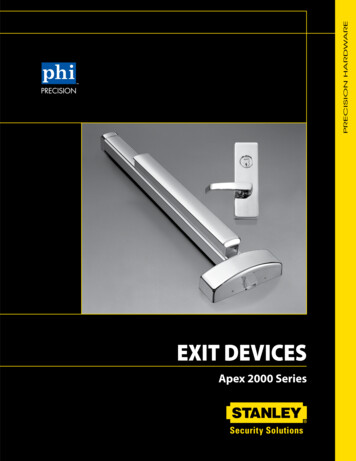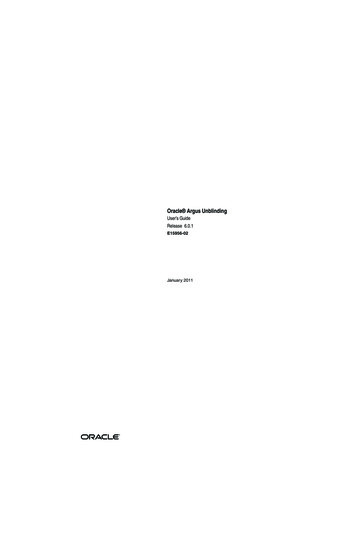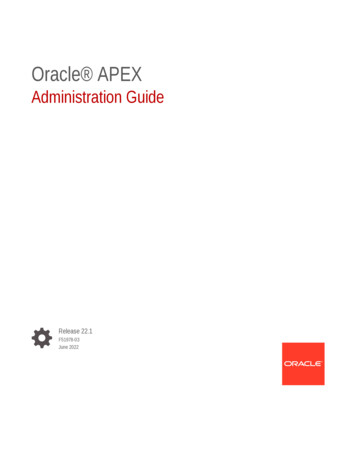
Transcription
Oracle APEXAdministration GuideRelease 22.1F51978-03June 2022
Oracle APEX Administration Guide, Release 22.1F51978-03Copyright 2003, 2022, Oracle and/or its affiliates.Primary Author: Terri JenningsContributors: Ananya Chatterjee , Christina Cho, Carsten Czarski, Caryn Dietrich , John Godfrey, DanielHochleitner , Christian Neumueller, Christian Rokitta , John Snyders, Jason Straub, Vladislav UvarovThis software and related documentation are provided under a license agreement containing restrictions onuse and disclosure and are protected by intellectual property laws. Except as expressly permitted in yourlicense agreement or allowed by law, you may not use, copy, reproduce, translate, broadcast, modify, license,transmit, distribute, exhibit, perform, publish, or display any part, in any form, or by any means. Reverseengineering, disassembly, or decompilation of this software, unless required by law for interoperability, isprohibited.The information contained herein is subject to change without notice and is not warranted to be error-free. Ifyou find any errors, please report them to us in writing.If this is software or related documentation that is delivered to the U.S. Government or anyone licensing it onbehalf of the U.S. Government, then the following notice is applicable:U.S. GOVERNMENT END USERS: Oracle programs (including any operating system, integrated software,any programs embedded, installed or activated on delivered hardware, and modifications of such programs)and Oracle computer documentation or other Oracle data delivered to or accessed by U.S. Government endusers are "commercial computer software" or "commercial computer software documentation" pursuant to theapplicable Federal Acquisition Regulation and agency-specific supplemental regulations. As such, the use,reproduction, duplication, release, display, disclosure, modification, preparation of derivative works, and/oradaptation of i) Oracle programs (including any operating system, integrated software, any programsembedded, installed or activated on delivered hardware, and modifications of such programs), ii) Oraclecomputer documentation and/or iii) other Oracle data, is subject to the rights and limitations specified in thelicense contained in the applicable contract. The terms governing the U.S. Government’s use of Oracle cloudservices are defined by the applicable contract for such services. No other rights are granted to the U.S.Government.This software or hardware is developed for general use in a variety of information management applications.It is not developed or intended for use in any inherently dangerous applications, including applications thatmay create a risk of personal injury. If you use this software or hardware in dangerous applications, then youshall be responsible to take all appropriate fail-safe, backup, redundancy, and other measures to ensure itssafe use. Oracle Corporation and its affiliates disclaim any liability for any damages caused by use of thissoftware or hardware in dangerous applications.Oracle, Java, and MySQL are registered trademarks of Oracle and/or its affiliates. Other names may betrademarks of their respective owners.Intel and Intel Inside are trademarks or registered trademarks of Intel Corporation. All SPARC trademarks areused under license and are trademarks or registered trademarks of SPARC International, Inc. AMD, Epyc,and the AMD logo are trademarks or registered trademarks of Advanced Micro Devices. UNIX is a registeredtrademark of The Open Group.This software or hardware and documentation may provide access to or information about content, products,and services from third parties. Oracle Corporation and its affiliates are not responsible for and expresslydisclaim all warranties of any kind with respect to third-party content, products, and services unless otherwiseset forth in an applicable agreement between you and Oracle. Oracle Corporation and its affiliates will not beresponsible for any loss, costs, or damages incurred due to your access to or use of third-party content,products, or services, except as set forth in an applicable agreement between you and Oracle.
ContentsPrefaceAudiencexiiDocumentation AccessibilityxiiDiversity and InclusionxiiiRelated DocumentsxiiiConventionsxiii1Changes in Release 22.1 for Oracle APEX Administration Guide2Workspace and Application Administration2.1Understanding Workspace Administration2.1.1What is a Workspace Administrator?2-32.1.2Accessing the Workspace Administration Page2-42.1.3Workspace Administration Page2-52.1.4Resetting Your Password2-62.1.5Viewing Product Release and Environment Information2-72.1.6Managing Export Files in the Current Workspace2-82.1.7Managing Saved Interactive Reports2-82.1.7.1About Saved Interactive Reports2-92.1.7.2Viewing and Deleting Saved Interactive Reports2-92.1.7.3Managing Interactive Report Subscriptions2.1.82.3Viewing a Workspace Summary2-102-102.1.8.1Viewing the Workspace Utilization Report2-102.1.8.2Emailing the Workspace Utilization Report2-11Requesting a Workspace in Workspace Administration2-112.1.92.22-2Using the Manage Service Page2-132.2.1Accessing the Manage Service Page2-132.2.2Manage Service Page2-14Making a Service Request2.3.1Determining the Space Available in a Workspace2.3.1.1Viewing the Detailed Tablespace Utilization Report2-152-162-17iii
2.42.3.2Viewing the Service Request History for the Workspace2-172.3.3Requesting a New Schema2-172.3.4Requesting More Storage2-182.3.5Requesting Another Workspace2-182.3.6Terminating a Workspace2-19Configuring Workspace Preferences2-202.4.12.5Managing Workspace Account Login Controls2-202.4.1.1About Login Controls2-212.4.1.2Configuring Workspace Account Login Controls2-212.4.2Controlling Access to App Builder2-222.4.3Controlling Access to SQL Workshop2-232.4.4Disabling PL/SQL Program Unit Editing for a Workspace2-232.4.5Enabling RESTful Services and Defining a Path Prefix for a Workspace2-242.4.6Configuring Team Development in an Existing Workspace2-252.4.7Configuring Session Timeout for a Workspace2-26Defining a Workspace Message2-272.5.1About Workspace Messages2-282.5.2Defining and Editing Workspace Messages2-292.6Configuring an Environment Banner for a Workspace2-302.7Managing Users in a Workspace2-312.82.7.1About Oracle APEX Accounts Authentication2-322.7.2About Oracle APEX User Roles2-322.7.3Creating User Accounts2-332.7.3.1Creating a New User Account2-332.7.3.2Creating Multiple Users Simultaneously2-352.7.4Editing Existing User Accounts2-362.7.5Locking and Unlocking a User Account2-372.7.6Changing a User Account Password2-382.7.7Deleting User Accounts2-382.7.7.1Deleting a Single User Account2-392.7.7.2Deleting Multiple Users at Once2-392.7.8Viewing the Users Dashboard2-392.7.9Using Groups to Manage Oracle APEX Users2-402.7.9.1About Groups2-412.7.9.2Creating a Group2-412.7.9.3Editing an Existing User Group2-412.7.9.4Adding and Removing Users from a Group2-422.7.9.5Assigning a Group to Another Group2-422.7.9.6Viewing Group Assignments2-43Accessing the Data Dictionary Cache Report from Workspace Administration2.8.12-43Viewing or Refreshing the Workspace Data Dictionary Cache2-43iv
2.9Purging the Developer Activity and Click Count Log Files2-442.9.1Purging the Developer Activity Log2-452.9.2Purging the External Click Count Log2-45Managing Session State for a Workspace2-452.102.10.1About Session State2-462.10.2Removing Session State After Reviewing Session Details2-462.10.3Viewing Session State for the Current Session2-472.10.4Purging Sessions by Age2-482.10.5Purging Session State for the Current Session2-482.11Managing User Preferences2.11.1Setting User Preferences2-492-492.11.1.1Setting User Preferences by Creating a Page Process2-492.11.1.2Setting the Source of an Item Based on a User Preference2-502.11.1.3Setting User Preferences Programmatically2-512.11.2Viewing Preferences by User2-512.11.3Viewing Current User Preferences2-522.11.4Purging Preferences for a Specific User2-522.11.5Purging Preferences for the Current User2-532.11.6Removing User Preferences Programmatically2-532.11.7Resetting User Preferences Using a Page Process2-532.12Managing Page and Region Caching2.12.12.13Purging Cached Regions and PagesChanging Build Status for Multiple Applications2-542-552-552.13.1About Changing Application Build Status2-562.13.2Managing Build Status in Workspace Administration2-562.14Leveraging App Builder Defaults2-572.14.1About App Builder Defaults2-572.14.2Configuring App Builder Defaults2-57Monitoring Activity Within a Workspace2-582.152.15.1Accessing the Monitor Activity Page in Workspace Administration2-592.15.2Viewing Application Changes by Developer2-592.15.3Viewing Application Changes by Day2-602.15.4Viewing Active Sessions2-602.15.4.1What is an Active Session?2-612.15.4.2Viewing the Active Sessions Report2-612.15.52.16Viewing Schema Reports and Other ReportsViewing Workspace Dashboards2-612-622.16.1Accessing the Workspace Dashboards2-632.16.2Workspace Dashboard2-632.16.3Users Dashboard2-642.16.4Activity Dashboard2-64v
32.16.5Developer Activity Dashboard2-642.16.6Performance Dashboard2-652.16.7Applications Dashboard2-652.16.8Database Dashboard2-65Oracle APEX Administration Services3.13.2Understanding Administration Services3.1.1What Is an Instance Administrator?3-33.1.2Signing In To Administration Services3-43.1.3Overview: Administration Services UI3-53.1.3.1Administration Services Home Page3-53.1.3.2Manage Instance Page3-83.1.3.3Manage Workspaces Page3-113.2.1About Workspace Requests and Change Requests3-123.2.2Viewing Requests on the Administration Services Home Page3-133.2.3Viewing Pending Requests3-133.2.4Managing Workspace Requests3-143.2.4.1About the Workspace Request Approval Process3-153.2.4.2Approving or Declining a Pending Workspace Request3-163.2.4.3Changing the Status of an Existing Workspace Request3-163.2.4.4Deleting a Workspace Request3-17Managing Change Requests3.2.5.13-17Approving or Declining a Pending Change Request3-18Managing Feature Configuration3.3.13.43-10Managing Requests3.2.53.33-23-18Configuring Application Development Settings3-193.3.1.1Disabling PL/SQL Program Unit Editing for an Instance3-193.3.1.2Enabling the Creation of Demonstration Objects in New Workspaces3-203.3.1.3Configuring the Number of Application Backups3-203.3.2Configuring SQL Workshop3-213.3.3Configuring Monitoring3-223.3.3.1Enabling Database Monitoring3-223.3.3.2Enabling Application Activity Logging3-233.3.3.3Enabling Web Service Activity Logging3-233.3.3.4Enabling Application Tracing3-243.3.4Enabling RESTful Services for an Instance3-253.3.5Enabling Service Requests3-253.3.6Configuring Team Development for New Workspaces3-26Configuring Security3.4.13-27Configuring Service-level Security Settings3-28vi
3.4.1.1Controlling Workspace Cookies3-293.4.1.2Controlling Persistent Authentication3-293.4.1.3Disabling Access to Administration Services3-303.4.1.4Enabling Access to Oracle APEX Administration Services3-313.4.1.5Disabling Workspace Login Access3-313.4.1.6Controlling Public File Upload3-323.4.1.7Restricting User Access by IP Address3-323.4.1.8Configuring a Proxy Server for an Instance3-333.4.1.9Selecting a Checksum Hash Function3-333.4.1.10Configuring Rejoin Sessions for an Instance3-343.4.1.11Configuring Unhandled Errors3-35Configuring HTTP Protocol Attributes3-363.4.23.4.2.1About SSL3-363.4.2.2Requiring HTTPS3-373.4.2.3Reversing Require HTTPS3-373.4.2.4Reversing Require Outbound HTTPS3-383.4.2.5Configuring Additional Response Headers3-393.4.3Enabling Real Application Security3-393.4.4Configuring Session Timeout for an Instance3-403.4.5Isolating All Workspaces in an Instance3-413.4.5.1About Isolating Workspaces to Prevent Browser Attacks3-413.4.5.2Configuring Instance-Level Workspace Isolation Attributes3-423.4.6Defining Excluded Domains for Regions and Web Services3-443.4.7Configuring Authentication Controls for an Instance3-453.4.7.1About Authentication Controls3-453.4.7.2Configuring Security for Developer and End User Login3-463.4.7.3Configuring Authentication Schemes for an Instance3-463.4.7.4Configuring Security Settings for Workspace Administrator andDeveloper Accounts3-583.4.83-593.4.8.1About Strong Password Policies3-593.4.8.2Configuring Password Policies3-593.4.93.5Creating Strong Password PoliciesManaging Authorized URLs3-613.4.9.1Defining a List of Authorized URLs3-613.4.9.2Editing a Defined Authorized URL3-623.4.9.3Deleting Defined Authorized URL3-62Configuring Instance Settings3-623.5.1About Configuring Workspace Provisioning3-643.5.2Disabling Email Provisioning3-643.5.3Configuring Storage3-653.5.3.1Requiring a New Schema3-65vii
3.5.3.2Enabling Auto Extend Tablespaces3-663.5.3.3Enabling Bigfile Tablespaces3-663.5.3.4Enabling Encrypted Tablespaces3-673.5.3.5Enabling Automatic Approval of Storage Requests3-673.5.3.6Deleting Uploaded Files3-683.5.4About Enabling Network Services3-693.5.4.2Configuring Email in a Full Development Environment3-703.5.4.3Configuring Email in a Runtime Environment3-713.5.4.4Determining Email Settings in a Runtime Environment3-72Configuring Wallet Information3-723.5.5.1About SSL and Wallet Creation3-733.5.5.2Configuring a Wallet in a Full Development Environment3-733.5.5.3Configuring a Wallet in a Runtime Environment3-743.5.5.4Determining Wallet Settings in a Runtime Environment3-753.5.6Configuring Report Printing for an Instance3-753.5.6.1About Configuring Report Printing3-753.5.6.2Configuring Report Printing in a Full Development Environment3-763.5.6.3Configuring Report Printing Settings in a Runtime Environment3-773.5.6.4Determining Report Printing Settings in a Runtime Environment3-783.5.7Configuring Workflow Settings3-793.5.8Configuring the Application Gallery3-793.5.8.1About the Application Gallery3-803.5.8.2Special Use Cases3-803.5.93.73-693.5.4.13.5.53.6Configuring EmailConfiguring the Help Menu3-843.5.10Configuring Workspace Size Requests3-843.5.11Managing Application ID Range3-853.5.12Configuring Background Jobs3-85Managing Public Themes3-863.6.1Adding a Public Theme to the Theme Repository3-863.6.2Deleting a Public Theme3-873.6.3Modifying a Public Theme3-873.6.4About Exporting a Public Theme3-88Managing Meta Data3.7.13-88Managing Session State for an Instance3-883.7.1.1About Session State3-893.7.1.2Viewing Session Details Before Purging3-893.7.1.3Purging Sessions by Age3-903.7.1.4Viewing Session Statistics Before Purging3-903.7.2Managing the Mail Queue3.7.2.13-90Sending and Deleting Messages in the Mail Queue3-91viii
3.7.3Viewing Installed Translations3-913.7.4Deleting Interactive Report Subscriptions3-923.8Communicating Using Messages, Banners, and Resources List3.8.1Defining a Login Message3-923-933.8.1.1About Login Messages3-933.8.1.2Creating or Editing the Login Message3-943.8.2Defining a System Message3-953.8.2.1About System Messages3-953.8.2.2Creating and Editing a System Message3-953.8.3Defining a Workspace Message in Administration Services3-963.8.4Configuring an Environment Banner in Administration Services3-963.8.5Managing a Site-Specific Resources List3-983.93.8.5.1Adding a New Task3-993.8.5.2Editing an Existing Task3-993.8.5.3Deleting a TaskCreating a Service Signup Wizard3-1003-1003.9.1Defining a Service Signup Wizard3-1003.9.2Running a New Service Signup Wizard3-1013.10Managing Schemas3-1023.10.1What Is the Oracle APEX Engine Schema?3-1023.10.2Determining the Oracle APEX Engine Schema3-1033.10.3Understanding Oracle Default Schema Restrictions3-1033.113.10.3.1About Assigning Oracle Default Schemas to Workspaces3-1043.10.3.2Granting the Privilege to Assign Oracle Default Schemas3-1043.10.3.3Revoking the Privilege to Assign Oracle Default Schemas3-1053.10.3.4Working with Restricted Schemas3-1053.10.3.5Determining the Privilege Status3-106Creating Workspaces in Administration Services3-1073.11.1About Workspaces3-1083.11.2About Specifying How Workspaces Are Created3-1083.11.3Selecting a Workspace Provisioning Mode3-1093.11.4How Oracle-Managed Files Affects Workspace Provisioning3-1103.11.5Creating a Workspace Manually3-1113.11.5.1Creating Workspace Manually in a Full Development Environment3-1113.11.5.2Creating a Workspace Manually in a Runtime Environment3-1123.11.63.12Creating Multiple WorkspacesManaging Existing Workspaces3-1133-1143.12.1Performing a Workspace Search3-1163.12.2Editing Workspace Information3-1163.12.3Isolating a Workspace to Prevent Browser Attacks3-1193.12.3.1About Isolating a Workspace to Prevent Browser Attacks3-119ix
3.12.3.23.12.4Configuring Workspace Isolation Attributes3-120Deleting a Workspace3-1233.12.4.1Identifying and Deleting Inactive Workspaces3-1233.12.4.2Deleting Workspaces in a Full Development Environment3-1253.12.4.3Deleting Workspaces in a Runtime Development Environment3-1263.12.5Locking a Workspace3-1263.12.6Purging Inactive Workspaces3-1273.12.6.13.12.7Configuring Workspace Purge Settings3-127Managing Workspace to Schema Assignments3.12.7.13-128Viewing Schema and Workspace Assignments in a DevelopmentEnvironment3-129Viewing Schema and Workspace Assignments in a RuntimeEnvironment3-1293.12.7.3Editing Existing Schema and Workspace Assignments3-1303.12.7.4Associating Schemas in a Full Development Environment3-1303.12.7.5Associating Additional Schemas in a Runtime Environment3-1313.12.7.6Removing a Schema Mapping from a Workspace in a RuntimeEnvironment3-1313.12.7.23.12.8Managing Component Availability for an Instance3-1323.12.9Exporting and Importing a Workspace3-1333.12.9.1About Exporting and Importing a Workspace3-1333.12.9.2Exporting a Workspace in Administration Services3-1343.12.9.3Importing a Workspace in Administration Services3-134Installing Exported Applications in a Runtime Environment3-1353.12.103.12.10.1About the Advantages of Using Runtime Environment3-1353.12.10.2Installing an Exported Application in to a Runtime Environment3-1363.12.11Exporting and Importing from a Command Line3-1363.12.11.1Exporting and Importing Using SQLcl3-1373.12.11.2Exporting Using the APEXExport Utility (Deprecated)3-1543.12.12Changing Application Build Status in Administration Services3-1573.12.12.1About Changing Application Build Status3-1583.12.12.2Changing Build Status in Administration Services3-1583.12.13Viewing the Application Attributes Report3-1593.12.14Accessing Workspace Reports3-1593.12.14.1Viewing the Workspace Details Report3-1603.12.14.2Viewing Workspace Database Privileges3-1613.12.14.3Viewing File Size and File Count by Workspace3-1613.12.14.4Finding and Emailing Workspace Summary3-1623.12.14.5Accessing the Data Dictionary Cache Report from AdministrationServices3-1623.12.153.13Viewing the Parsing Schemas Report3-163Managing Users Across an Oracle APEX Instance3-164x
3.13.1About the Advantages of Managing Users at the Instance Level3-1643.13.2About Oracle APEX Accounts Authentication3-1653.13.3About Oracle APEX User Roles3-1653.13.4Creating New User Accounts in Administration Services3-1653.13.5Editing an Existing User Account in Administration Services3-1673.13.6Deleting User Accounts in Administration Services3-1673.143-1683.14.1About Web Server Logs3-1683.14.2Accessing the Monitor Activity Page in Administration Services3-1693.14.3Viewing the Signup Survey Report3-1703.14.4Viewing the Backup Log3-1713.15AMonitoring Activity Across an InstanceConfiguring and Deleting Logs and Log Entries3-1713.15.1Deleting SQL Workshop Logs3-1723.15.2Deleting Page View Activity Log Entries3-1733.15.2.1About Page View Activity Logs3-1733.15.2.2Truncating Page View Activity Logs Manually3-1733.15.3Deleting Developer Activity Log Entries3-1743.15.4Managing Developer Log Retention3-1743.15.5Deleting Click Counting Log Entries3-1753.15.6Deleting the Login Access Log3-1753.15.7Managing Log Intervals3-1763.15.8Archiving the Activity Log3-1763.15.9Deleting Web Service Log Entries3-1763.15.10Configuring or Deleting the REST Source Synchronization Log3-1773.15.11Configuring or Deleting the Automation Log3-177DBMS SCHEDULER JobsA.1List of DBMS SCHEDULER JobsA-1Indexxi
PrefacePrefaceOracle APEX is a hosted declarative development environment for developing anddeploying database-centric web applications. APEX turns a single Oracle databaseinto a shared service by enabling multiple workgroups to build and access applicationsas if they were running in separate databases.Oracle APEX Administration Guide describes how to perform administration tasks foran Oracle APEX workspace, application, or an entire development instance. Audience Documentation Accessibility Diversity and Inclusion Related Documents ConventionsAudienceOracle APEX Administration Guide describes how to perform administration tasks foran Oracle APEX workspace, application, or an entire development instance.To use this guide, you must have a general understanding of relational databaseconcepts and an understanding of the operating system environment under which youare running Oracle APEX.See Also:Oracle APEX Installation GuideDocumentation AccessibilityFor information about Oracle's commitment to accessibility, visit the OracleAccessibility Program website at http://www.oracle.com/pls/topic/lookup?ctx acc&id docacc.Access to Oracle SupportOracle customers that have purchased support have access to electronic supportthrough My Oracle Support. For information, visit http://www.oracle.com/pls/topic/lookup?ctx acc&id info or visit http://www.oracle.com/pls/topic/lookup?ctx acc&id trsif you are hearing impaired.xii
PrefaceDiversity and InclusionOracle is fully committed to diversity and inclusion. Oracle respects and values having adiverse workforce that increases thought leadership and innovation. As part of our initiative tobuild a more inclusive culture that positively impacts our employees, customers, andpartners, we are working to remove insensitive terms from our products and documentation.We are also mindful of the necessity to maintain compatibility with our customers' existingtechnologies and the need to ensure continuity of service as Oracle's offerings and industrystandards evolve. Because of these technical constraints, our effort to remove insensitiveterms is ongoing and will take time and external cooperation.Related DocumentsFor more information, see these Oracle resources: Oracle APEX Release Notes Oracle APEX Installation Guide Oracle APEX End User’s Guide Oracle APEX App Builder User’s Guide Oracle APEX SQL Workshop Guide Oracle APEX API Reference Oracle Database ConceptsConventionsThe following text conventions are used in this document:ConventionMeaningboldfaceBoldface type indicates graphical user interface elements associated with anaction, or terms defined in text or the glossary.italicItalic type indicates book titles, emphasis, or placeholder variables for whichyou supply particular values.monospaceMonospace type indicates commands within a paragraph, URLs, code inexamples, text that appears on the screen, or text that you enter.xiii
1Changes in Release 22.1 for Oracle APEXAdministration GuideAll content in Oracle APEX Administration Guide has been updated to reflect release 22.1functionality.New Features and UpdatesThe following features are new in Oracle APEX: Enable customers to get back into action faster with the new persistent authentication.Sign in once, stay signed in.See Controlling Persistent Authentication. Support of Oracle SQL Developer Command Line (SQLcl)Export workspaces, applications, and related files from a command line using OracleSQL Developer Command Line (SQLcl) release 22.1 and later.See Exporting and Importing Using SQLcl. Workflow SettingsUse the Retention Period in Days attribute to specify the number of days human taskscreated by Approvals are retained before being purged.See Configuring Workflow Settings. Application Gallery SettingsConfigure the location used as the installation source for Application Gallery.See Configuring the Application Gallery. Instance Administration Home Page ChangesThe following new popup LOVs display under Instance Tasks on the AdministrationServices home page: Jump to app and Jump to user.See Administration Services Home Page.Deprecated and Desupported FeaturesSee Deprecated Features and Desupported Features in Oracle APEX Release Notes.1-1
2Workspace and Application AdministrationIn an Oracle APEX development environment, users sign in to a shared work area called aworkspace. Workspace administrators monitor and administer a shared work area called aworkspace. Understanding Workspace AdministrationUse Workspace Administration to monitor and administer a workspace. Using the Manage Service PageUse the Manage Service page to manage service requests, configure workspacepreferences, edit workspace messages, and view reports. Additionally, administrators usethis page to clear log files, manage session state, clear cached content, and manageinteractive report settings. Making a Service RequestWorkspace administrators use the Request Service page to request a schema, addstorage space, terminate a workspace, or request another workspace. Configuring Workspace PreferencesConfigure workspace preferences for workspace login controls, access to App Builderand SQL Workshop, support for PL/SQL editing and RESTful services, and access toTeam Development. Defining a Workspace MessageWorkspace administrators can quickly communicate with other users by creatingworkspace messages. Configuring an Environment Banner for a WorkspaceConfigure a environment banner for a workspace on the Workspace Administration page. Managing Users in a WorkspaceCreate new user accounts, manage existing user accounts, and change user passwords. Accessing the Data Dictionary Cache Report from Workspace AdministrationAccess the Data Dictionary Cache report from Workspace Administration to viewstatistics and data analysis of schema tables and caches in a workspace. Purging the Developer Activity and Click Count Log FilesManually purge developer logs and the External Count Clicks log on the Log files page.Log entries older than one month are automatically deleted. Managing Session State for a WorkspaceA session establishes persistence (or stateful behavior) across page views. Workspaceadministrators can view session details for the current session or for recent sessions,purge the current session state, or purge sessions based on their age. Managing User PreferencesDevelopers can use preferences to store values for a specific Oracle APEX user acrossdistinct sessions. Once set, these preferences can be removed programmatically ormanually. Administrators can set user preferences by creating a page process, by thecalculation of a preference Item Source Value, or programmatically by using a PL/SQLAPI.2-1
Chapter 2Understanding Workspace Administration Managing Page and Region CachingImprove an application's performance by taking advantage of page and regioncaching. Changing Build Status for Multiple ApplicationsConfigure the Build Status attribute at the workspace-level to prevent anapplication from being modified by other developers. Leveraging App Builder DefaultsApp Builder Defaults enable developers to reduce the number of steps needed tocreate a new application. Monitoring Activity Within a WorkspaceMonitor developer activity and changes within a workspace by accessing theMonitor Activity page. Viewing Workspace DashboardsUse the Dashboard page to view details about the current workspace and monitoroverall workspace activity.See Also: Oracle APEX Administration Services Understanding Developer Security Best Practices in Oracle APEX AppBuilder User’s Guide2.1 Understanding Workspace AdministrationUse Workspace Administration to monitor and administer a workspace.Note:Many configuration options are available at both the workspace andinstance-level. Instance-level settings generally override similar settingsfound in Workspace Administration. What is a Workspace Administrator?Workspace administrators have all the rights and privileges available to developerand manage administrator tasks specific to a workspace. Accessing the Workspace Administration PageUse the Workspace Administration page to monitor and administer a workspace. Workspace Administration PageUse the Workspace Administration page to manage service requests, manageusers and groups, monitor activity, view dashboards, view the Utilization Report,change your password, manage interactive report settings, manage the ExportRepository, and request a new workspace. Resetting Your PasswordReset your password by clicking Change My Password under Tasks on theWorkspace Administration page.2-2
Chapter 2Understanding Workspace Administration Viewing Product Release and Environment InformationAccess the About APEX page to view basic product information, including the APEXrelease number, workspace name, environment details, and database information. Managing Export Files in the Current WorkspaceUse the Manage Export Repository to manage Export files in the current workspace. Managing Saved Interactive ReportsView and delete saved interactive reports as well as manage interactive reportsubscriptions. Viewing a Workspace SummaryUse the Workspace Utilization report to view a comprehensive summary of the currentworkspace, including summaries of schemas, applications, SQL Workshop scripts andresults, Team Development details, application activity, developer activity, and counts ofdatabase objects. Requesting a Workspace in Workspace AdministrationRequest a workspace on the Workspace Administration page.2.1.1 What is a Workspace Administrator?Workspace administrators have all the rights and privileges available to developer andmanage administrator tasks specific to a workspace.In Oracle APEX, users sign in to a shared work area called a workspace. A workspaceenables multiple users to work within the same APEX installation while keeping their objects,data and applications private. This flexible architecture enables a single database instance tomanage thousands of applications.Within a workspace,
2.7.1 About Oracle APEX Accounts Authentication 2-32 2.7.2 About Oracle APEX User Roles 2-32 2.7.3 Creating User Accounts 2-33 2.7.3.1 Creating a New User Account 2-33 2.7.3.2 Creating Multiple Users Simultaneously 2-35 2.7.4 Editing Existing User Accounts 2-36 2.7.5 Locking and Unlocking a User Account 2-37 2.7.6 Changing a User Account .
